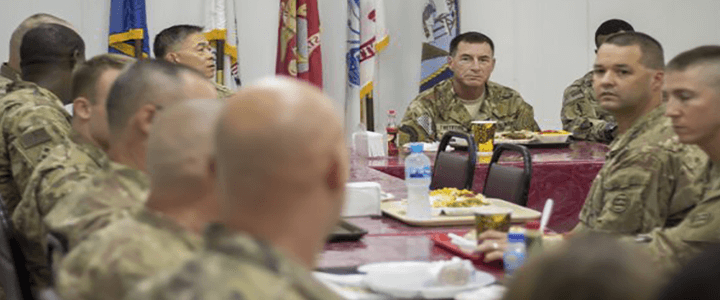Leaders act. The led perceive. Between actions and perceptions there’s a gulf of time and space. Across the gulf—because of the time and space differences—actions may very well be misperceived. Of course, perceptions aren’t everything. But they matter. Perceptions aren’t everything because the reality of what’s perceived matters, too. But distorted perceptions of even the most genuine, appropriate, and defensible decisions are dangerous. Failure to acknowledge and build bridges across that time-space gulf between leaders and led, between command and staff, between executives and personnel was central to the potentially disastrous dysfunction in U.S. Central Command’s (CENTCOM’s) Directorate of Intelligence (CCJ2).
PERCEPTIONS at centcom intelligence
What the CCJ2 staff saw happening in their organization was unacceptable and demanded action. That is, leaders who “falsified, distorted, suppressed, or delayed intelligence products.” The perception was that a triumvir of conspirators were poisoning intelligence processes to “present a more optimistic portrayal of the success of USCENTCOM’s efforts . . . .” Naturally, career intelligence professionals who’d long dedicated their lives to their craft were incensed. And the longer the perceptions persisted, rumors spread, resentment mounted, the more destructive the apparent mis-perceptions became.
Ultimately, 30 formal complainants and others among 120 who witnessed the CCJ2 activities were convinced that their world was being pulled down around them by malicious, unethical leadership. As the report explains, there were “many individuals who agreed with the complainants’ allegations or certain parts of their allegations, or some of the other allegations. Many other witnesses disagreed with those allegations, some strenuously, and other witnesses had no opinion or knowledge of the issues raised by these allegations.” Imagine the dysfunction inside the already stressed organization—whispered conversations, drawing of lines, division among groups, eroding trust, and increasing paranoia even further distorting every decision and deed.
REALITY
According the Department of Defense Office of the Inspector General’s (DoD IG’s) exhaustive investigation and comprehensive report, CCJ2 leadership wasn’t maliciously unethical and bent on violating the sanctity of the intelligence processes. In fact, “CCJ2 senior intelligence leaders adamantly denied that they falsified, distorted, delayed, or suppressed intelligence.” Of course they did. What really was happening, according to the IG report, subjects of the investigation explained that any “changes to analysts’ products were based on analytic tradecraft and were intended to improve the products.” Ultimately, none of the very believable allegations were substantiated.
THE BRIDGE
The bridge between actions and perceptions is good communication. And it’s a two-way bridge. Leaders should know that the logic or purpose of just one action or decision can be interpreted in a variety of different ways. Now, multiply those myriad interpretations for one decision by ten, 100, or 1,000. Distortion, misunderstanding, is inevitable, especially during times of real or perceived crisis, especially when the organization is under incredible stress, especially when the work being done is a matter of life and death. Ideally, every member of the organization should have a clear understanding of the organization’s vision, of the executives’ leadership philosophies. People should know who they work for.
Trust is important. It’s fair to expect that over the course of many, many decisions, members of the organization generally trust the judgment and motivation of the leadership. But building trust takes time. Preserving trust takes good two-way communication and routine interaction. Without that, even the greatest degree of trust becomes incrementally degraded, until trust is justifiably not enough to sustain the faith of the organization. And in the most stressful, high-demand environments, a mentality of self-preservation and self-righteousness starts springing up. If it continues to grow unchecked, ignored, denied, or minimized, the organizational dysfunction and failure is inevitable.
BE PRESENT
The first lesson the DoD IG shared from its investigation is presence. “Leaders,” the report reads, “should find ways to sustain a reasonable presence . . . and to provide direct feedback, especially during crisis work.” If the leadership is apparently protected from the people in the sanctum sanctorum, after a while, suspicion and rumors will naturally grow. And being present means being present to everyone, which is tough, but that’s why leaders are paid so well (generally). Leaders “should continue to implement methods to communicate with the entire workforce across work locations and shifts, such as brown bag lunches, town halls, anonymous suggestion boxes (physical or virtual), and sessions with analysts, immediate supervisors, and middle managers.”
KEEP TALKING
How many times has a leader espoused an incredibly effective, meaningful, powerful vision for the organization only to find that, beyond the headquarters—however, big or small the headquarters is—no one has really heard about or truly understands the vision, much less applied that vision to daily decisions and efforts. According to the IG, “leaders should communicate feedback, guidance, and intent in a variety of techniques and settings, and verify that the message is reaching the analysts. Leaders should also verify that their direction was received and understood.” It’s not simply not enough to have good intentions. It’s not enough to have a truly spectacular leadership philosophy. Its not enough to have great values and an inspiring vision. These are concepts that have to be inculcated in the organization. They have to be talked about. They have to be seen and heard. Ultimately, people have to believe in them and apply them to their own work. And achieving that’s not easy. But that’s why leaders are paid so well (generally).
There are many, many more important lessons to glean from the disaster averted at USCENTCOM CCJ2, and if you’re interested in organization success, they just can’t be missed.




